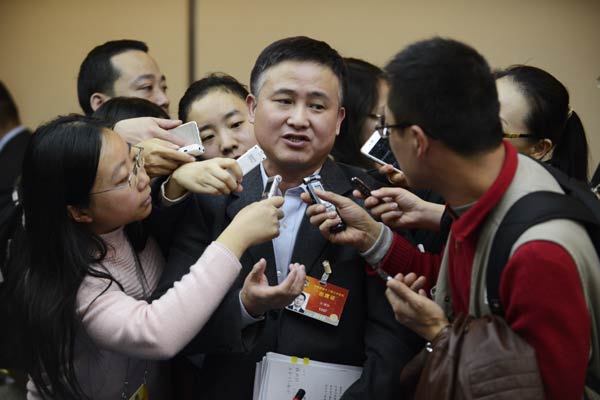China to issue guidelines for Web finance companies soon
By JIANG XUEQING/MENG JING (China Daily) Updated: 2015-03-05 07:46
 |
|
CPPCC member Pan Gongsheng, also deputy governor of the central bank, answers reporters' queries on Wednesday after a panel discussion of the ongoing annual session of the top advisory body, which is being held in Beijing. [WEI XIAOHAO/FOR CHINA DAILY] |
China will soon come out with guidelines for the healthy development of the Internet finance sector, a top banking official said on Wednesday.
Pan Gongsheng, deputy governor of the central bank and a member of the National Committee of the Chinese People's Political Consultative Conference, said that the People's Bank of China, the nation's central bank, will play a lead role in formulating the guidelines and also establish a regulatory framework for the Internet finance sector.
The upcoming regulations have sparked interest among members of the CPPCC National Committee this year as Internet financial products and services have grown rapidly in China.
China has already become the world's largest peer-to-peer lending market. By the end of September 2014, about 1,400 peer-to-peer lending platforms had raised funding of 110 billion yuan ($18 billion). The total assets of Yu'ebao, an online monetary fund operated by the Chinese e-commerce giant Alibaba Group Holding Ltd, amounted to 578.9 billion yuan at the end of last year.
With the fast development of Internet finance, the existing regulation system, which relies mainly on administrative regulation, can no longer cater to the growing demands of the financial sector, He Qiang, a professor with the Central University of Finance and Economics, said in his proposals to China's top advisory body this year.
The ongoing financial reform must move toward strengthening market regulations to unlock the full potential, said He, who is also a member of the CPPCC National Committee.
"The government should make a scientific risk assessment system for Internet finance based on quantitative indicators, rather than calling off financial products and services simply because they may cause relatively high financial risks," he said.
For innovative financial products with large volume, he suggested that the government should consider the relevant financial institution's ability to control and handle the risk, instead of tightening regulations due to possible negative effects associated with such products.
- Israel requests to join Asian Infrastructure Investment Bank
- Chinese stocks rebound on April 1
- China, the West in Africa: more room for cooperation than competition
- Nanjing cuts taxi franchise fees
- Air China increases flights to Milan, Paris
- JD.com raises delivery charges
- Veteran corporate strategist upbeat about China economy
- L'Oreal China sales revenue up 7.7% in 2014

















